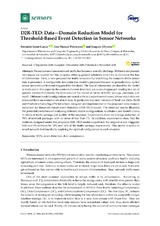D2R-TED: Data—Domain ReductionModel for Threshold-Based Event Detection in Sensor Networks
Autor
León, Fernando
Palomares Muñoz, José Manuel
Olivares Bueno, Joaquín
Editor
MDPIFecha
2018Materia
WSNEvent detection
Data compression
METS:
Mostrar el registro METSPREMIS:
Mostrar el registro PREMISMetadatos
Mostrar el registro completo del ítemResumen
The reduction of sensor network traffic has become a scientific challenge. Different compression techniques are applied for this purpose, offering general solutions which try to minimize the loss of information. Here, a new proposal for traffic reduction by redefining the domains of the sensor data is presented. A configurable data reduction model is proposed focused on periodic duty–cycled sensor networks with events triggered by threshold. The loss of information produced by the model is analyzed in this paper in the context of event detection, an unusual approach leading to a set of specific metrics that enable the evaluation of the model in terms of traffic savings, precision, and recall. Different model configurations are tested with two experimental cases, whose input data are extracted from an extensive set of real data. In particular, two new versions of Send–on–Delta (SoD) and Predictive Sampling (PS) have been designed and implemented in the proposed data–domain reduction for threshold–based event detection (D2R-TED) model. The obtained results illustrate the potential usefulness of analyzing different model configurations to obtain a cost–benefit curve, in terms of traffic savings and quality of the response. Experiments show an average reduction of 76% of network packages with an error of less than 1%. In addition, experiments show that the methods designed under the proposed D2R–TED model outperform the original event–triggered SoD and PS methods by 10% and 16% of the traffic savings, respectively. This model is useful to avoid network bottlenecks by applying the optimal configuration in each situation.

